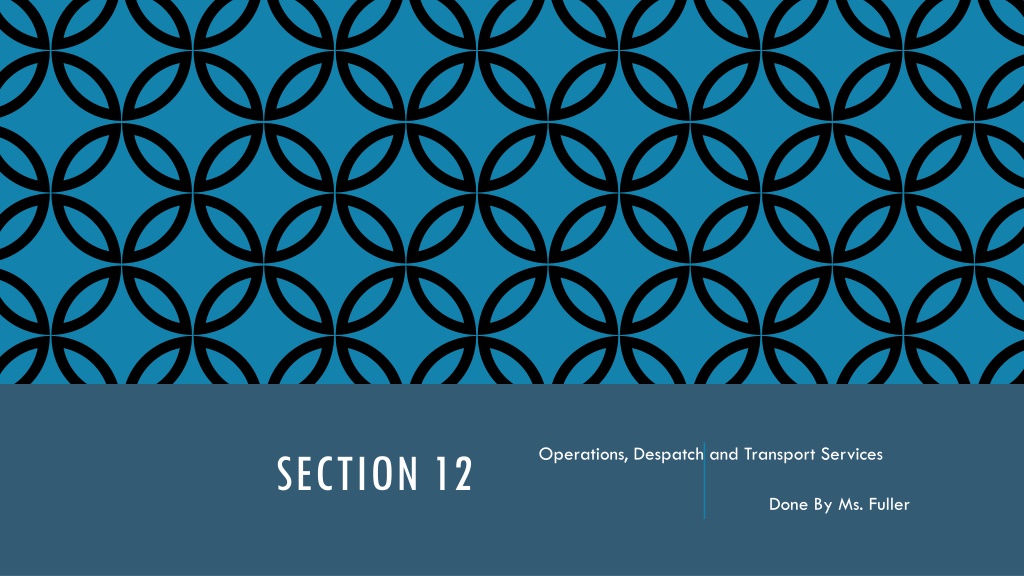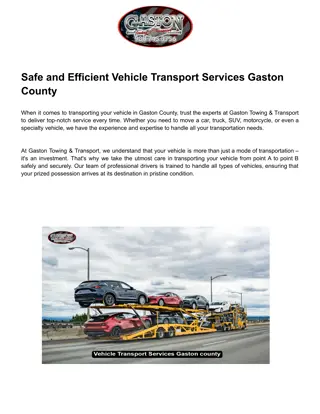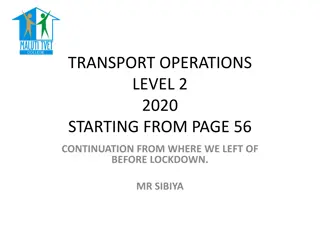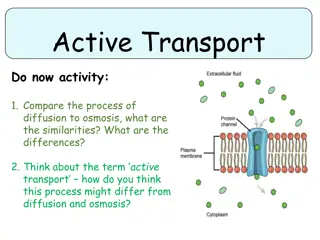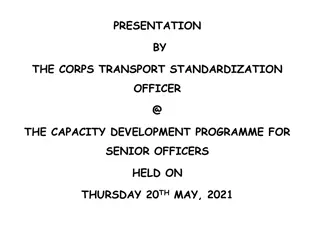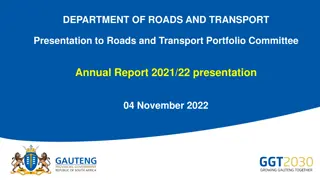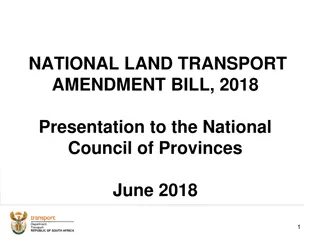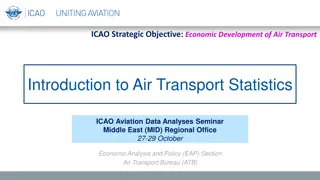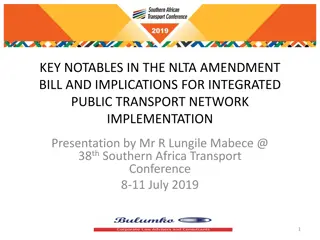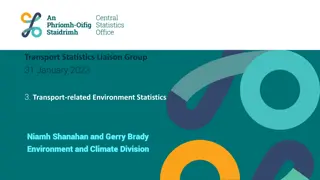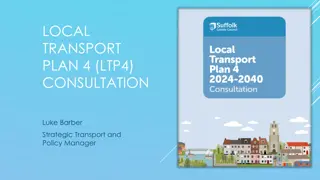Operations, Despatch, and Transport Services Overview
The operations office focuses on production activities, ensuring compliance with regulations, worker safety, quality assurance, cost control, and interdepartmental coordination. The despatch office handles the dispatch of goods, maintains documentation, collaborates with sales, and manages couriers for efficient delivery processes.
Download Presentation

Please find below an Image/Link to download the presentation.
The content on the website is provided AS IS for your information and personal use only. It may not be sold, licensed, or shared on other websites without obtaining consent from the author. Download presentation by click this link. If you encounter any issues during the download, it is possible that the publisher has removed the file from their server.
E N D
Presentation Transcript
Operations, Despatch and Transport Services SECTION 12 Done By Ms. Fuller
FUNCTIONS OF THE OPERATIONS OFFICE The operations office is concerned with the activities relating to production. The functions of the operations office include: i) achieved and the statutory rules and regulations are carried out and a safe working environment is provided for employees. Coordinating activities related to production This is to ensure that a profit is ii) important at all stages of the production process. As such, the Factories Act provides minimum guidelines in relation to the safety of employees. Once statutory requirements are met production workers will be happy in their working environment. Protecting workers and the environment The health and safety of employees is iii) for future reference Maintenance of factory records Factory records are to be kept and maintained iv)
iv ) Quality assurance; awareness of standards ISO Quality assurance is an important aspect of production and requires the standardization of the quality of products. For example, if a product does not have a certain quality, it is bad for the producer and business can be lost. Consumers expect the same quality and standard with each purchase at all times. The International Organisation for Standardisation (ISO) is responsible for the setting of voluntary standards aimed at safeguarding consumers. This allows for the manufacture and supply of goods and services to be efficient, safe and clean. v) Costing of finished products For a business to make a profit it is important that the cost of producing the goods or services is clearly established, so as not to exceed the selling price. For example, if a company decides to sell a product for $10 it would be good sense to check and ensure that the product does cost say $12 to produce. vi) Liaising with other departments It is important that the operations office liaise with other departments to ensure the smooth operation and flow of information. The operations office acts as the link between the factory office.
FUNCTIONS OF THE DESPATCH OFFICE i) Maintain documents for dispatch of goods Goods prepared for dispatch must be carefully checked against the original order before being packaged and recorded on the delivery note. This is to ensure the correct quantities of goods are sent and that they are in good condition. Insurance documentation may be provided by the despatch office. ii) Maintain database of couriers/contractors/agents Maintaining a database of couriers, contractors and a gents can be useful. Since they are used to carry out deliveries it would be good to maintain a database, which will be regularly updated. iii) Work in collaboration with the sales office The despatch office will need to work with the sales office so that goods sold can be despatched, and also to advise them on promises that may be made to customers in relation to the dispatching of goods, and to ensure that promises made to customers are fulfilled. The reputation of the business can be affected if the collaboration is not efficient. For example, if a promise was made to a customer for the dispatch of goods on a certain date and it was not done, this could have a negative impact on the business, especially if it happens frequently.
iv) consideration the type of goods being supplied, the method of transport used and the distance over which the delivery is to be made. These procedures are regulated by company policy as well as statutory regulations. For example, it may be company policy to use a specific type of carton for various products. There are statutory regulations in the way certain products such as chemicals and other hazardous materials are packaged, and special labelling regulations such as customs declarations and certificate of origin. Adhere to statutory requirements The packing process takes into v) keep the transport office informed of orders to be despatched. This ensures that goods are delivered to the customer in the right condition and at the right time and that drivers as well as vehicles are scheduled effectively. If the organisation does not have a transport office then the dispatch office will carry out this function. Coordinate delivery of goods It is the responsibility of the dispatch office to
FUNCTIONS OF THE TRANSPORT OFFICE i) damaged or lost as well as records related to drivers, records of vehicles used and maintenance carried out or to be scheduled for maintenance. ii) Maintain destination sheets A destination sheet reflects the order in which drivers will make deliveries. It gives route details and deliveries to be done on a particular day. This ensures that the route is followed in a logical sequence and avoids the waste of time and fuel. Earlier deliveries will be placed at the entrance of the vehicle and later ones at the back. As the driver proceeds from one delivery address to another, the next delivery will become readily accessible. iii) Liaise with customers Customers may make enquiries about the timing of the delivery of their orders. The transport office can refer to their copy of the destination sheet and inform the customer as to when their goods is expected to be delivered. Similarly, the customer could also report a non- delivery and by using the destination sheet the transport office should be able to give an explanation as to what happened. iv) Maintenance of vehicles It is the responsibility of the transport office to schedule regular maintenance of vehicles so as to reduce the possibility of too many vehicles being off the road at the same time. The transport office would need to take into account the need for statutory testing of vehicles to ensure road worthiness. The age and condition of vehicles and the miles covered since they were last serviced. Maintain transportation records The transport office will maintain records of goods that were
DUTIES OF A CLERK IN THE OPERATIONS OFFICE i) which comprises the times each team of workers is required to work when the times of working (shift) changes. He/she will need to organize the hours of work for the employees. Preparing a shift roster ensures that the burden of working varying hours is spread evenly among employees and adequate time off is given without interrupting the flow of production. There may also be the need to rotate shifts so each employee experience working varying shifts. Preparation of shift roster The clerk in the operations office is responsible for preparing the shift roster ii) output. This information is used for future planning as jobs are done according to plan. Preparation of daily production reports The clerk will need to report on the daily productivity levels and iii) records/documents are readily available for use when required. He/she will also be involved in the creation and preparation of documents. Preparation of documents used in production The operations clerk is responsible for ensuring that iv) the operations clerk will need to complete. These include job cards, job cost card, cost analysis, planning masters, cost cards and time cards. A job card records all information relevant to the job in hand. The job cost card gives specific information about the cost (fixed and variable) of producing a particular unit of production eg. Cost of fuel, salaries and labour and materials. This information is used to determine the price of the goods produced. A cost analysis card or cost summary sheet provides information on the cost of several jobs. The planning master contains details of the entire production process and the rate of production that should be attained. A time card is used to record the actual time an employee spends working. The information is used to calculate wages Completion of forms used in factory office There are a number of forms, cards and other documentation that
DUTIES OF A CLERK IN THE DISPATCH OFFICE i) documents used in the dispatch of goods such as delivery note and other documentation related to the supply against customers orders. Completion of documents for dispatched goods the clerk in the dispatch office will complete ii) Storage of information of couriers employed - iii) maintenance of the database of transport couriers, agents and contractors i.e keeping updated contact information for them. Maintain database of couriers, transport contractors and agents the clerk will be involved in the iv) sales, customer services and marketing departments to ensure that customers needs are met. Liaise with sales, customer services and marketing departments the clerk will need to liaise with the v) requirements are met such as special arrangements required for hazardous materials, and the health and safety of employees in relation to the office and store rooms. Adhering to statutory requirements The dispatch clerk will also have to ensure that statutory vi) on time and in good condition. Coordination of delivery of goods the clerk will need to ensure that customers order are delivered
DUTIES OF A CLERK IN THE TRANSPORT OFFICE i) records that are related to the functions of the transport office. Maintain transportation records the clerk will maintain transportation ii) maintain destination sheets, which are used to instruct drivers of the order in which deliveries are to be done Maintain destination sheets It is the duty of the transport office clerk to iii) delivery times will be done by the transport office clerk. This requires tact and diplomacy. Liaise with customers Liaising with customers when they make enquiries about iv) to be carried out by the transport office clerk. This involves ensuring that vehicles are roadworthy and properly serviced to ensure efficiency of delivery. Schedule maintenance of vehicles This may be one of the most difficult task
DOCUMENTS USED IN OPERATIONS, DESPATCH AND TRANSPORT a) Delivery schedule This helps to organize the efficiency of transportation for example, the expected use of vehicles and drivers. b) Destination sheets These sheets instruct the driver which routes to take and the deliveries to be made on a particular day. c) Delivery note When goods are being delivered to a customer, it is accompanied by a delivery note. It contains details of the items being delivered, how they are carried, the number of cartons/crates and the method of transportation for example, road. Two copies are carried where one is to be signed by the customer (consignee) and taken back by the driver as proof of delivery. d) Bill of lading This is used when goods are sent by ship. It serves as evidence that the goods were actually placed on board the ship. e) Customs forms when goods are sent overseas there are certain regulations that must be adhered to. These regulations include customs declaration forms, certificate of origin and export license; these may vary from one country to another.
f) Insurance certificate Some goods require insurance coverage to allow claims to be made for damages or loss that may occur during transit. The insurance certificate is issued by an insurance company and confirms that coverage have been taken out on the items/goods for which they agree to compensate for loss or damage during transportation. Depending on the arrangement, the buyer or seller may pay the premium. g) Airway bills This is used when goods are transported overseas by air (aircraft). It contains information such as name and address of consignor (seller); name and address of consignee (buyer) and details of the goods. The main aim of an airway bill is to protect the airline carrier should it become necessary for the consignor to make a claim for damage or loss of goods whilst in transit. h) company will only accept responsibility for loss or damage caused by their employees. Other losses caused by fire, or bad weather must be covered by insurance. Manifest This is a summary of all the bills of lading and cargo a ship is carrying. The shipping
i) Export and import license An export license is usually required before some items are allowed to leave a country. It is a document that gives permission for an individual or company to export particular goods. The import license is a document issued by the importing country for certain goods to come into the country. Some countries may place a limit or quota on the number of a particular goods that is allowed to enter that country. j) Advice note This is used to inform a customer that the goods ordered will be or have been dispatched on a particular date. It may also give an indication as to how long it should take for the goods to arrive at its destination. It is sent separately from the goods and alerts the consignee to expect the arrival of the goods or consignment. k) Certificate of origin This is a document which states the country of origin of the goods being shipped. It states where certain goods were produced, manufactured or processed. l) Freight note This is a bill for the carrying of goods. It is sent to the person exporting the goods (exporter) by the shipping company for payment or to the importer if the goods were sent ex-works (where transport costs are extra to the selling price).
